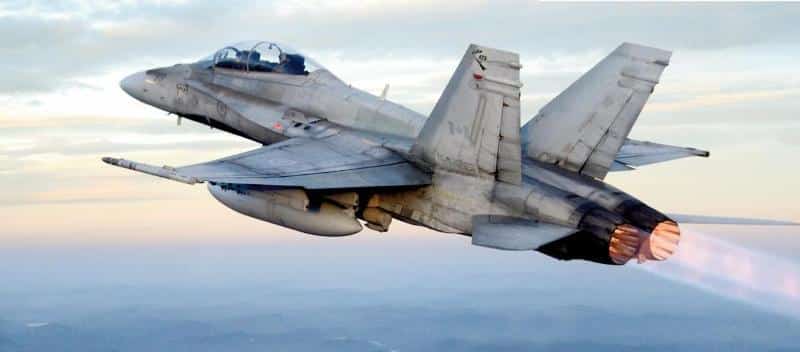It is through a press release that Airbus DS, member of the Eurofighter consortium in charge of marketing the Typhoon, and the British authorities who made the offer to the Canadian authorities, announced the withdrawal of the European multi-purpose fighter from the competition aimed at replacing the fleet of CF-18 fighters which currently equip the Royal Canadian Air Force. 2 arguments were put forward, in a very diplomatic manner, to explain this withdrawal.
Firstly, the European manufacturer believes that the technological constraints linked to the joint air defense between the United States and Canada, identified by the term “2 Eyes”, and managed by NORAD, are likely to create significant additional costs. incompatible with the desire to submit a financially competitive offer expressed by Airbus. On the other hand, it seems that the Canadian authorities have modified their assessment of the different criteria of the offers made, and have significantly reduced the relative weight of the industrial compensation presented by the manufacturers, which represented one of the main arguments of the offer accompanying the Typhoon.
With the withdrawal of Rafale in November 2018, only the American planes remaining in this competition, the F35A from Lockheed-Martin and the F/A 18 E/F Super Hornet from Boeing, as well as the Swedish aircraft JAS 39 E/F Gripen from the manufacturer Saab, whose chances seem, in view of the arguments put forward by Airbus for the withdrawal of the Typhoon, we could not be more restricted. Many observers believe that Saab should also withdraw from the competition soon enough, as the Swedish company's chances are so low today. In fact, the authorities in Ottawa now seem to have to choose between the Lockheed aircraft, which was widely criticized by Benjamin Trudeau when he took office, or the Super Hornet from the manufacturer Boeing, the same one which launched a legal offensive in 2017. furious with the Canadian manufacturer Bombardier for preventing it from selling its short and medium haul aircraft in the United States.

We could have believed the Typhoon partly built by Airbus DS as in an excellent position to win this market. Indeed, the twin-engine configuration and speed of the European aircraft, optimized for Air Defense, represents a significant asset for ensuring the defense of Canadian vastness. Above all, it was Airbus which came to the aid of Bombardier in 2018, going so far as to integrate Canadian aircraft into the range of Airbus aircraft, to the detriment of its own short-haul aircraft such as the A319. In addition, relations between Canadian Prime Minister Justin Trudeau and his turbulent neighbor Donald Trump have been tumultuous to say the least since the American president took office.
In fact, the arguments put forward by Airbus for the withdrawal of the Typhoon are reminiscent of those who explained the withdrawal of the Franco-Italian FREMM from the competition concerning the Canadian frigate program. In fact, the Canadian authorities demanded very advanced technological information from manufacturers, far exceeding the information transmitted during international competitions. Naval Group and the Italian Fincantieri estimated that, given the proximity of Canadian shipyards, which required this information, to American and British defense industrial groups, the risks of leaks of competitive technological information were very high. The attempt to present an offer outside the competition, as Dassault did in Belgium, received a very hostile reception from the Canadian authorities. Whether they were more upset by the refusal of European groups to submit to the requirements of the call for tenders, or by the suspicions of truncated competition that this refusal engendered, we will probably never know.

Above all, these arguments recall the way in which NATO put pressure on Belgiume so as not to be able to consider any alternatives other than that of the F35A to replace its F16s. Indeed, although this has not been the mission of the Belgian air forces since the creation of NATO, the latter informed, when the competition was already launched, that Belgian aircraft would be required to carry out a majority of SAED missions aimed at eliminate the enemy's anti-aircraft defenses, and that they therefore had to equip themselves with a 5th generation stealth aircraft, knowing that the only aircraft meeting these specifications was the F35A.
Regardless, the remaining alternatives for the Canadian Air Force are now far from being operationally satisfactory for the Canadian Air Force. Two aircraft, the JAS 39 and the F35A are single-engine aircraft, significantly increasing the risk of accidents, especially over vast territories with a low density of alternate terrain. They also have a reduced aspect ratio, and in the case of the F35A, a limited speed in the absence of supercruise. The Super Hornet therefore appears to be the most coherent alternative, despite the full-scale aggression carried out by Boeing against the Canadian aeronautical industry. Even beyond this political criterion, the device only has limited scalability over time, due to its dated design, and the replacement of the US Navy's Super Hornets by a 6th generation fighter from 2035 , according to Pentagon plans.

It is interesting to note that despite its GDP roughly equal to that of Russia, Canada today feels obliged to submit its destiny and the protection of its airspace to the arbitrations and pressures of Washington. On the other hand, where the country plans to acquire a little more than 80 aircraft of a unique model expected to last several decades to carry out all the missions, the Russian air forces, which they face in the far north, receive between 35 and 40 new devices each year, of different types (for 2019: Mig35, Su30, Su34, Su35 and Su57). We can therefore wonder if it is not the rigidity of the political model of Canadian Defense, and by transitivity of all Western countries, which today hinders the effectiveness of this Defense effort, and which creates excessive dependence on the United States?
